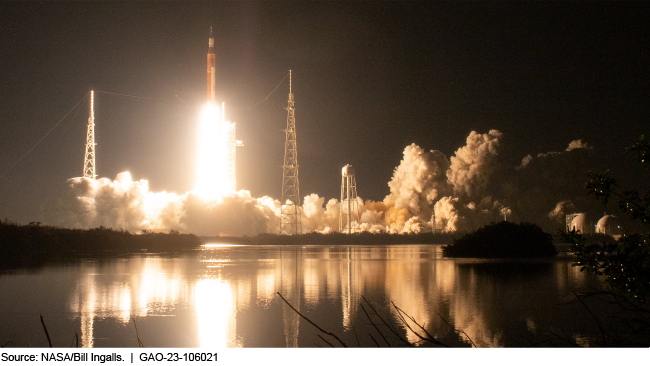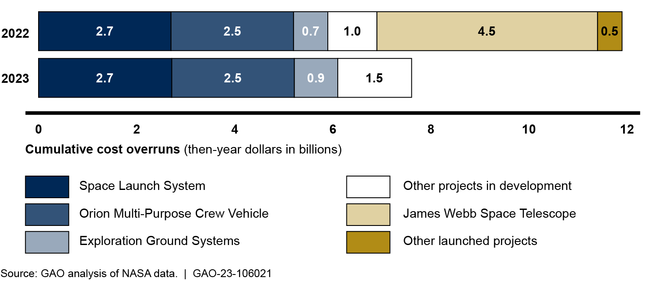NASA: Assessments of Major Projects
Fast Facts
NASA plans to invest over $83 billion in its major projects to continue exploring Earth, the moon, and the solar system. This is our 15th annual assessment of these projects.
In the last year, NASA decreased its total project "overruns"—when costs incurred are more than budgeted—by almost $5 billion. The agency's largest, most complex projects have the biggest impact on these overruns. A key factor in this decrease was that the James Webb Space Telescope launched and no longer counts toward the total overruns.
NASA has identified ways to improve existing and future major projects. NASA acquisition management is on our High Risk List.
Artemis I—one of NASA’s key missions—launched on November 16, 2022

Highlights

What GAO Found
Total cumulative cost performance for NASA's current portfolio of 16 major projects in development improved since 2022, with cost overruns significantly decreasing from $12 to $7.6 billion.
Cumulative Development Cost Overruns by Project in 2022 and 2023

Category 1 projects in development—NASA's highest priority and most costly, such as James Webb Space Telescope—drive NASA's cumulative cost performance. Cost overruns were smaller in 2023 than last year because the James Webb Space Telescope launched, and its $4.5 billion in overruns from prior years are no longer part of the portfolio. In addition, compared to 2022 performance, some of the largest category 1 projects—the Space Launch System, Orion, and Exploration Ground Systems—had little to no new cost growth. Overall, since 2022, eight of the 16 major projects experienced some cost or schedule growth, with cost overruns totaling $637.3 million and schedule delays ranging from 5 months to over a year.
As the portfolio of major projects evolves, NASA has identified opportunities to improve cost and schedule performance. For example, NASA plans to have earlier discussions on acquisition strategies. This and other initiatives are important as NASA plans to make cost commitments—estimated at nearly $16 billion—for eight new category 1 projects in 2023.
Why GAO Did This Study
NASA plans to invest more than $83 billion in its portfolio of major projects to continue exploring Earth, the moon, and the solar system. GAO defines these major projects as those with costs over $250 million. A House explanatory statement includes a provision for GAO to prepare status reports on NASA's major projects. This is GAO's 15th annual assessment.
This report describes the cost and schedule performance of NASA's major projects and includes assessments of their technology development. It also includes individual assessments of the major projects.
GAO collected and analyzed data; reviewed project status reports; and interviewed NASA officials. GAO reviewed projects in the formulation phase (which takes a project through its preliminary design), and those in the subsequent development phase (which includes building and launching the system).
Recommendations
In prior work, GAO made multiple recommendations to improve NASA's management of major projects. As of March 2023, NASA had not yet fully addressed 16 recommendations.
